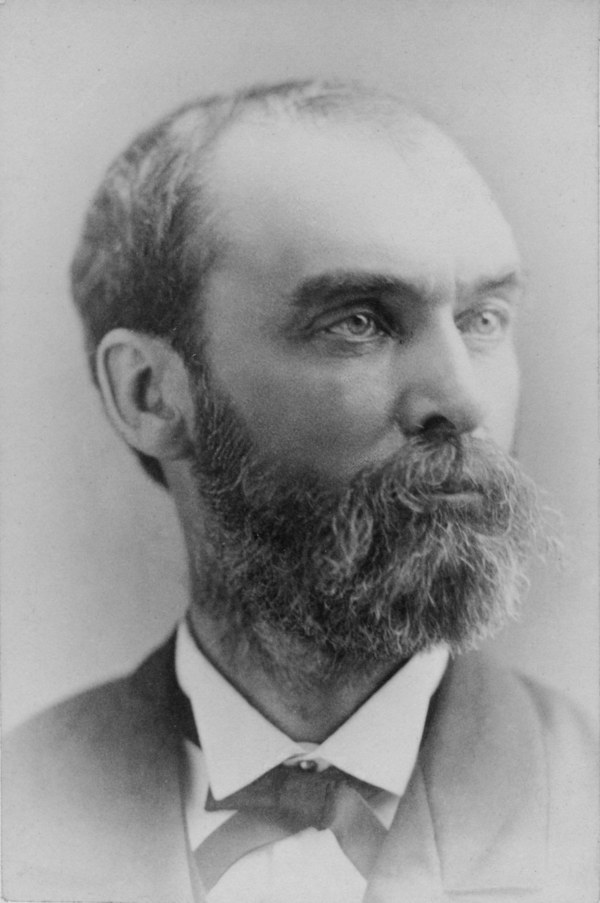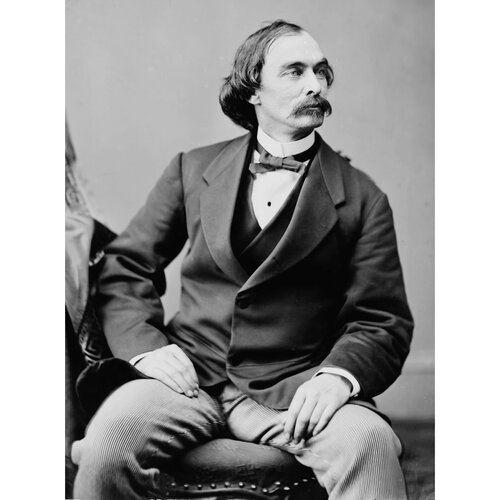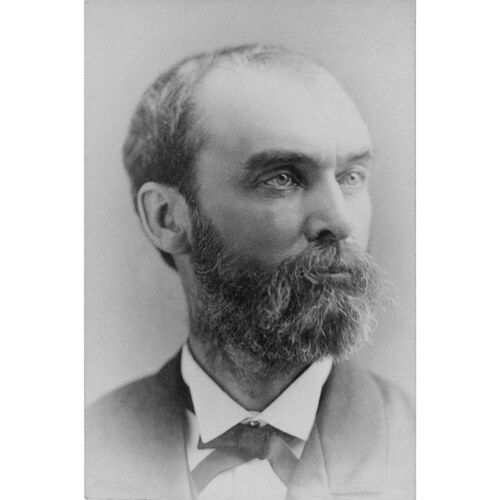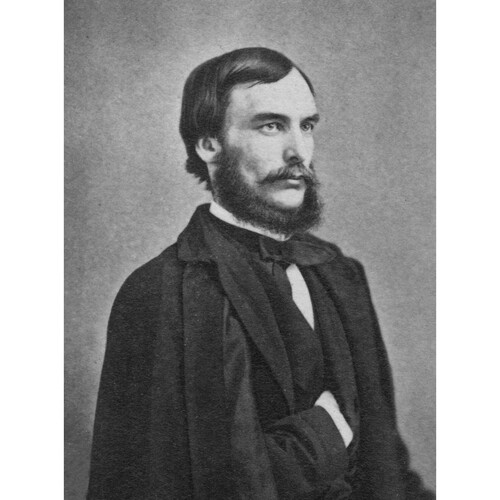
Source: Courtesy of Wikimedia Commons
HAYES, ISAAC ISRAEL, physician and Arctic explorer; b. 5 March 1832 in Chester County, Penn., son of Benjamin Hayes and Ann Barton; d. unmarried 17 Dec. 1881 in New York City.
Isaac Israel Hayes was a descendant of an Oxfordshire family which had settled in Chester County in the 18th century. He attended Westtown Academy from 1838 to 1848, and in 1852 became a medical student at the University of Pennsylvania where he earned a doctorate in medicine. He had become interested in Arctic exploration and in May 1853 volunteered to serve as surgeon under Elisha Kent Kane* aboard the brig Advance on the second expedition supported by Henry Grinnell, a New York merchant, to search for Sir John Franklin*. Hayes led the party that in 1854 discovered and explored Grinnell Land (Ellesmere Island). He was also in charge of a party that attempted unsuccessfully to reach Upernavik, the nearest Inuit settlement, after Kane had been forced to spend a second winter in the Arctic. When the expedition returned to New York in 1855, Hayes had a permanently mutilated foot. In An Arctic boat journey he gave a graphic description of the hardships he had experienced and an excellent clinical account of the various forms of scurvy that had killed many of the crew.
In July 1860 Hayes took command of the schooner United States at Boston for another expedition financed by Grinnell. He hoped to approach the pole via the open sea which he believed to exist north of the 85th parallel. The expedition’s scientific endeavours were, however, badly hurt by the death of its astronomer, August Sonntag, who with Hans Hendrik, an Inuit guide, attempted a futile trip to obtain more dogs after their pack had been hit by an epidemic of Arctic rabies. Hayes made one of the earliest clinical studies of this epizootic, which has not yet been completely explained; clearly an affection of the central nervous system, Arctic rabies had a high morbidity among dog teams, with loss of discipline, temper, and control of motor activity but no hydrophobia. Hayes managed to complete the survey of Grinnell Land as far as what he thought was 81°35´ where he saw open sea.
Returning to New York in 1861, Hayes joined the Union army and was in command of Satterlee Army Hospital, West Philadelphia, during the Civil War. He rose from the rank of major to brevet-colonel. After demobilization he went into business in a shipping company in New York, giving up the practice of medicine. He did, however, maintain his interest in the Arctic, giving much of his time to writing and lecturing. In 1867 he published The open polar sea, and in 1868 Cast away in the cold, a book for children.
Hayes’s third and last Arctic expedition was to Greenland in 1869 aboard the brig Panther. The trip was financed by William Bradford, a well-known artist of marine and Arctic scenes, who assumed charge of photography and illustration on the expedition. Hayes looked after the geographical and geological observations, especially those of glaciology, and published an account of the expedition’s findings in The land of desolation in 1871. He also presented illustrations and photographs of the expedition, including those of William Bradford, in The Arctic regions (London, 1873).
After this Greenland expedition Hayes was busy as a lecturer, newspaper reporter, free lance writer, and politician. From 1875 until his death in 1881 he was a Republican member of the New York State assembly. He never lost touch with exploration, being an active member of the American Geographical Society of New York and a close associate of its president, Charles Patrick Daly. He was influential in the decision of the society to sponsor its first Arctic expedition, a search for the records and logs of the lost Franklin expedition. Although Hayes may have been disappointed when he was not chosen to lead this expedition, he gave his fullest support to the man chosen, Lieutenant Frederick Schwatka*.
The Arctic achievements of Dr Hayes were substantial and he received gold medals from the Société de Géographie (Paris) and the Royal Geographical Society (London). Although his observations have been shown to be not always completely accurate with regard to detail, in their broader scope, and in their account of Greenland’s glaciers, they were sound. Hayes was an advocate of the theory of the open polar sea, but in this error he was in good company. We know now that the Kennedy Channel, which he had visited in 1860, and other parts of the Arctic Ocean are at unpredictable times open in the winter. Hayes and others merely extrapolated from their data the conclusion that the Arctic Ocean is always open near the pole. Perhaps Hayes’s most important achievement was that, like Charles Francis Hall* and Elisha Kent Kane, he explored what might be called the “American route” which was later used by Robert Edwin Peary to reach the North Pole.
I. I. Hayes was the author of “Address on Arctic exploration, delivered November 12, 1868,” American Geographical and Statistical Soc., Journal (New York), 2, pt. ii (1870): 1–31; An Arctic boat journey, in the autumn of 1854 (Boston, Mass., 1860); Cast away in the cold; an old man’s story of a young man’s adventures, as related by Captain John Hardy, mariner (Boston, [1868]); The land of desolation: being a personal narrative of adventure in Greenland (London, 1871); “Lecture on Arctic explorations,” Smithsonian Institution, Annual report (Washington), 1861: 149–60; Observations upon the relations existing between food and the capabilities of men to resist low temperatures (Philadelphia, 1859); The open polar sea: a narrative of a voyage of discovery towards the North Pole, in the schooner “United States” (New York, 1867); “Physical observations in the Arctic seas . . . ,” ed. C. A. Schott, Smithsonian Contributions to Knowledge (Washington), 15 (1867), article V; Pictures of Arctic travel . . . Greenland (New York), [1881]); “Remarks,” American Geographical Soc. of New York, Journal (New York), 12 (1880), 258–73; and “[Report of Dr Hayes’ Arctic expedition],” American Philosophical Soc., Proc. (Philadelphia), 8 (1861–62): 383–93.
American Geographical Soc. (New York), C. P. Daly corr., 1859–99. National Arch. (Washington), RC 94, Personal papers of medical officers and physicians prior to 1912, I. I. Hayes file. G. W. Cullum, “Biographical sketch of Doctor Isaac I. Hayes,” American Geographical Soc. of New York, Journal, 13 (1881): 110–24. W. H. Gilder, Schwatka’s search; sledging in the Arctic in quest of the Franklin records (New York, 1881). E. K. Kane, Arctic explorations: the second Grinnell expedition in search of Sir John Franklin, 1853, ’54, ’55 (2v., Philadelphia and London, 1856). [Frederick Schwatka], “Address,” American Geographical Soc. of New York, Journal, 12 (1880): 246–58. New-York Tribune, 18 Dec. 1881. DAB. The national cyclopædia of American biography (57v. to date, New York, [et al.], 1892– ), III: 280. J. S. Futhey and Gilbert Cope, History of Chester County, Pennsylvania, with genealogical and biographical sketches (Philadelphia, 1881). [S. C. Harry et al.], Proceedings of the bi-centennial gathering of the descendants of Henry Hayes . . . (West Chester, Pa., 1906). Arctic Pilot (London), III (5th ed., 1959).
Cite This Article
Robert E. Johnson, “HAYES, ISAAC ISRAEL,” in Dictionary of Canadian Biography, vol. 11, University of Toronto/Université Laval, 2003–, accessed March 29, 2025, https://www.biographi.ca/en/bio/hayes_isaac_israel_11E.html.
The citation above shows the format for footnotes and endnotes according to the Chicago manual of style (16th edition). Information to be used in other citation formats:
| Permalink: | https://www.biographi.ca/en/bio/hayes_isaac_israel_11E.html |
| Author of Article: | Robert E. Johnson |
| Title of Article: | HAYES, ISAAC ISRAEL |
| Publication Name: | Dictionary of Canadian Biography, vol. 11 |
| Publisher: | University of Toronto/Université Laval |
| Year of revision: | 1982 |
| Access Date: | March 29, 2025 |





